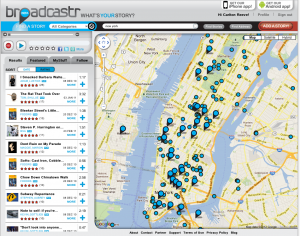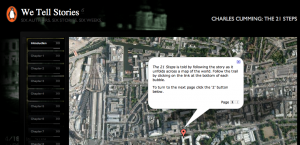Where was I? Location-based Stories
I’ve been thinking about location-based stories with some very bright students at the University of Bradford [I’m privileged to spend about 10% of my time lecturing]. I thought I would share the simple overview that I gave to them.
As David Polinchock over at FutureLab comments, location-based stories have exists as long as people have told stories but social and mobile media have transformed traditional methods and opened up exciting new possibilities.
There are at least 3 broad categories of new location-based stories:
- Static
- Wandering
- Virtual
Static
Static stories are pinned to a single physical location. New York-based Broadcastr sees itself as “an answer to the transient nature of social media” by “unlocking pictures and audio relevant to where you are.” It aims to create an historical archive of stories around the world, in addition to providing instant access to stories happening at the moment. The site allows you to listen to stories tied to specific places as well as share you own tales.
Although you can visit Broadcastr from anywhere via the web, the real impact of it is consuming the stories in situ – the act of standing in setting of the recollections is a powerful emotional experience.
The Getting Closer app by Krissy Clark makes that process easier by automatically triggering audio replays when you arrive physically at the location.
The Street Museum app by the Museum of London does a similar thing with historical photographs linked to places in the UK capital.
Other digital artists have extended this idea to link sites together to create journeys.
Wandering
Tim Wright‘s ‘Kidmapped‘ is a great example of using technology to retrace some literary steps. The project follows chapters 14–27 of Robert Louis Stevenson’s ‘Kidnapped’ and the story of David Balfour running for his life across the Highlands, sometimes accompanied by tough and rebellious Alan, sometimes pursued by the English army. Tim says that it ” seemed so visceral and exciting to me that I wanted to try it for myself.”
Tim’s blog combines the retelling of the story in the original setting with his own experiences of travelling the path and an invitation to join in either in person along the route or online. It’s a very intimate but accessible insight into the literature that provides a new way of understanding classic literature.
The We Tell Stories initiative by Penguin and Six to Start explores original digital storytelling techniques and one in particular focusses on location-based tales. Chris Cummins’ story The 21 Steps (based on The Thirty-nine Steps by John Buchan) tells of Rick, a man with a checkered past who finds himself mixed up with a dangerous organization that wants him to smuggle a mysterious vial into Scotland. A blue line traces Rick’s path across satellite images from Google Maps as you work your way through the story by clicking on location markers.
The Langwitches blog has some very useful instructions on using Google Maps for digital storytelling.
Virtual
Stories don’t have to stay in real world locations to encourage travelling: the web provides a treasure trove of places to visit. Bernie Dodge coined the phrase “WebQuest” to describe a structured online exploration across multiple sites and it’s as good a term as any to talk about virtual location-based stories. Although mainly used to define consciously educational activities, the framework offers an interesting way of linking virtual sites into a coherent story. Random House’s The Da Vinci webquest is a simple example of how a multitude of websites and related activities can be tied together but still it’s more of a treasure hunt that a ‘proper’ story (that is, one that enjoys any of Aristotle’s Six Elements). I’d love to hear of better examples.
One of the questioned raised during the session was whether placing a story in its actual setting detracts from its ability to fire the imagination. Its an interesting thought. All too often new technologies are used lazily as a shortcut to ‘novelty;’ we’re left feeling dissatisfied by superficial projects that haven’t undergone the rigour associated with tradition forms of ‘published’ media. For me, the real potential for location-based stories is in their ability to make experiences deeper and more moving – and that’s worth working at.





One Response to “Where was I? Location-based Stories”